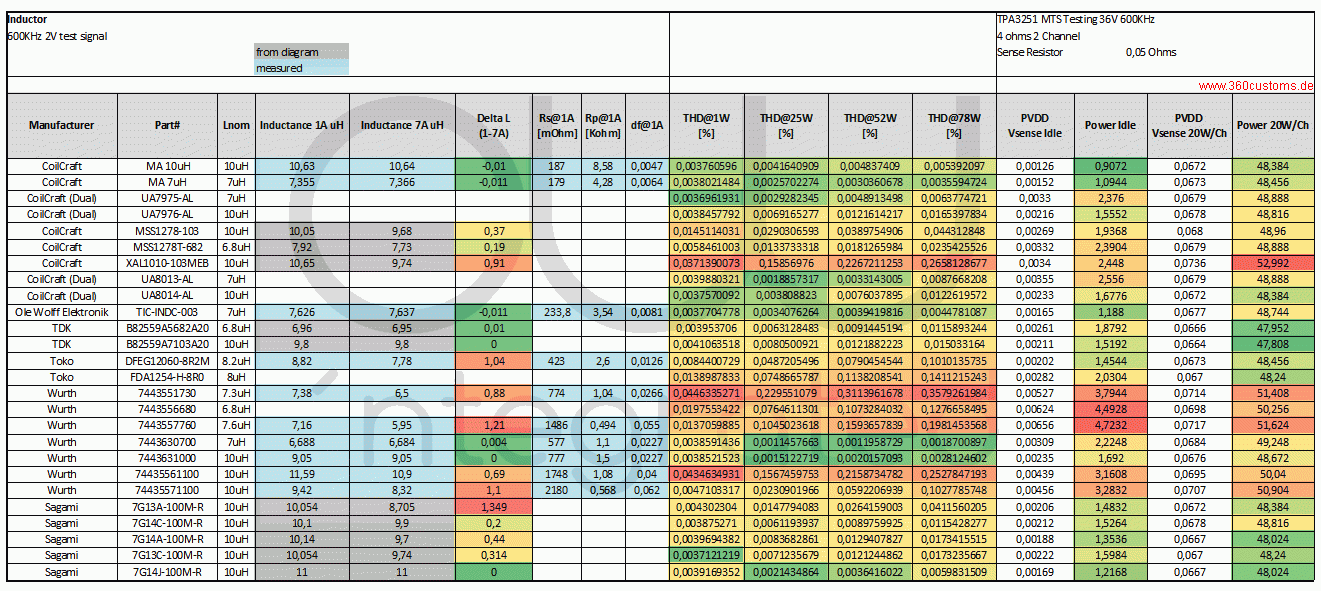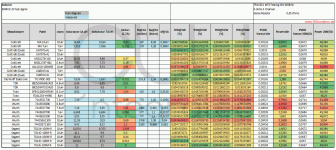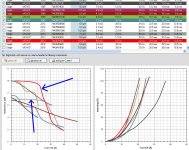That's great - thanks. Ti test gives v different performance for same 7 and 10 but that table suggests they are similar. Where does it come from and how were they tested? Do you know of tests that included air core inductors? With no current saturation, they might have lower THD ?That's easy, look into this..

Last edited:
The table is based on data from Texas Instruments Application Note and inductor comparison. I added some additional data from vendors datasheets and calculated some values from it - finally did heatmap rating to choose an inductor for my needs.
Several Coilcraft dual inductors shown in the table are still not available to buy. Those have also mentioned on the TPA3244/45EVM manuals.
Testing conditions are stated in the tables head. Would guess they've had used an AP to do the measurements.
Several Coilcraft dual inductors shown in the table are still not available to buy. Those have also mentioned on the TPA3244/45EVM manuals.
Testing conditions are stated in the tables head. Would guess they've had used an AP to do the measurements.
they've had used an AP to do the measurements.
I would not expect them to use our poor man's AP
Last edited:
With reference to doctormord post 1208.
Great data by the way.
Thank you.
I took a look at the Wurth inductors listed and looked up their data:
The two inductors with green in the "THDvsPWR" columns showed flat L vs I curves.
Makes sense.
Great data by the way.
Thank you.
I took a look at the Wurth inductors listed and looked up their data:
The two inductors with green in the "THDvsPWR" columns showed flat L vs I curves.
Makes sense.
Attachments
Wouldn't an air core also have a flat L vs I curve? Why does no-one test air cores? I dont understand why ppl say cored inductors are bad in speakers but ppl are using them for class-d saying how great they are. And the cored test results for the same inductor clearly differ - yet people think its accurate data. Something not right in the logic here?
Last edited:
Wouldn't an air core also have a flat L vs I curve?
Yes I reckon it would, fairly flat vs frequency too.
Why does no-one test air cores?
Could be because they know in advance what the answer is going to be? (see above
I dont understand why ppl say cored inductors are bad in speakers but ppl are using them for class-d saying how great they are.
Strange to me too. But most times the cored inductors I've seen in speakers have been open cores - ferrite rods for example, or similar rods made of steel laminations. I don't get why the same kind of construction isn't used for cored XO inductors as for cored classD inductors. In other words, shielded. When I make XO inductors for passive speakers I tend to make them shielded, with gapped ferrite cores.
Haha... good point. I suppose the only reason to test would be for different wire types, like silver, or shapes such as a hexagonal cross section to reduce air gap. Or just to prove air core will distort less.
I fully get that DC R will be higher and this will combine with inductance to alter frequency response, but since DC isn't music, isn't a sum of all impedances across the audio band more relevant than DC alone? No one worries about DC R in the speaker coils in isolation.
I have Solen and Jantzen coils that are big but they are mH not uH. I reckon as a wild guesstimate that a large thumb size would do it? Could fit on this evm... I'd live with power loss on a 120W amp if it sounded better at "normal" power levels.
As an application, I'm thinking of bi-amping so one channel for 20-2khz, and the other for over 2khz. The HF channel will be running at most 25% of the power of the LF channel, if the power split is around 20-80. So the HF coil could be significantly smaller and HF is where class D needs lower distortion too. Worth a try?
I fully get that DC R will be higher and this will combine with inductance to alter frequency response, but since DC isn't music, isn't a sum of all impedances across the audio band more relevant than DC alone? No one worries about DC R in the speaker coils in isolation.
I have Solen and Jantzen coils that are big but they are mH not uH. I reckon as a wild guesstimate that a large thumb size would do it? Could fit on this evm... I'd live with power loss on a 120W amp if it sounded better at "normal" power levels.
As an application, I'm thinking of bi-amping so one channel for 20-2khz, and the other for over 2khz. The HF channel will be running at most 25% of the power of the LF channel, if the power split is around 20-80. So the HF coil could be significantly smaller and HF is where class D needs lower distortion too. Worth a try?
Last edited:
High dcr, high flux.
Same meat, different gravy. Do you know that this chip has a specific DCR requirement? Has anyone tested this?
Last edited:
I suspect TI hadn't done this comparison for the DIYers but for system engineers/integrators. So no air cores.
When i'd choosen the WURTH 7uH inductors, i called Wurth support to help me out with additional measurements/tests like L=f(T) and L=f(f) for different currents.
When i'd choosen the WURTH 7uH inductors, i called Wurth support to help me out with additional measurements/tests like L=f(T) and L=f(f) for different currents.
Any advantage or disadvantage to the use of one or four output inductors? What is the trade-off besides the major increase in cost of using four coils, can you de-rate the coils current capabilities if you are using four rather than a single coil that can handle 10-15A @10uh or 7uh ?
- Home
- Amplifiers
- Class D
- TPA3251d2

